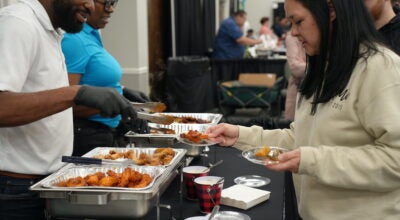Freezing summer’s produce bounty
Published 11:01 am Tuesday, June 30, 2009
Freezing is a quick and convenient way to preserve fruits and vegetables at home.
The method preserves the greatest quantity of nutrients. To maintain top nutritional quality in frozen fruits and vegetables, it is essential to:
Select fresh, firm-ripe produce, blanch vegetables as directed, store the frozen product at zero degrees and use within suggested storage times.
CHEMICAL CHANGES
Harvested fresh, fruits and vegetables continue to undergo chemical changes that can cause spoilage and deterioration of the product. This is why these products should be frozen as soon after harvest as possible and at their peak degree of ripeness. Enzymes in the fruits and vegetables must be inactivated to prevent the loss of nutrients and color and flavor changes that will occur.
Enzymes in vegetables
Enzymes are inactivated by the blanching process, which is the exposure of the vegetables to boiling water or steam for a brief period of time. The vegetable must then be cooled rapidly in ice water to prevent it from cooking.
Contrary to statements in some publications on home freezing, in most cases blanching is absolutely essential for producing top-quality, frozen vegetables. Blanching also helps to destroy microorganisms on the surface of the vegetable, brightens the color, helps retard loss of vitamins and helps make some vegetables, such as broccoli and spinach, more compact.
Enzymes in fruits
The major problems associated with enzymes in fruits are the development of brown colors and loss of vitamin C. Because fruits are usually served raw, they are not blanched like vegetables. Instead, ascorbic acid (vitamin C) is used either in its pure form or in commercial mixtures, such as Fruit Fresh, to control the activity of the enzymes.
Other methods to control browning include soaking the fruit in dilute vinegar solutions or coating the fruit with sugar and lemon juice. However, these latter methods do not prevent browning as effectively as treatment with ascorbic acid.
Preventing Rancid Flavors:
Rancid oxidative flavors may develop through contact of the frozen product with air. This problem can be prevented by using a wrapping material that does not permit air to pass into the product and by removing as much air as possible from the freezer bag or container before freezing.
TEXTURAL CHANGES
Cause of textural changes: Water makes up over 90 percent of the weight of most produce and is held within the fairly rigid cell walls that give support, structure and texture to the fruit or vegetable.
Freezing fruits and vegetables actually consists of freezing the water contained in the plant cell. When the water freezes, it expands, and the ice crystals cause the cell walls to rupture. The texture of the thawed produce will be much softer.
For example, when a frozen tomato is thawed, it turns into a pile of mush and liquid. This explains why celery, lettuce and tomatoes are not usually frozen, and why it is recommended that raw frozen fruits be eaten before they have completely thawed. Textural changes due to freezing are not as apparent in products cooked before eating.
When produce is frozen quickly, it forms a large number of small ice crystals. These small ice crystals produce less cell wall rupture than slow freezing, which produces only a few large ice crystals. This is why it is sometimes recommended that the temperature of a freezer be set at the coldest setting several hours before foods will be placed in the freezer. The maximum amount of product that can be frozen at one time is 2–3 pounds to each cubic foot of freezer space per 24 hours.
MOISTURE LOSS
Moisture loss, or ice crystals evaporating from the surface area of a product, produces freezer burn — a grainy, brownish spot where the tissues become dry and tough. This surface freeze-dried area is very likely to develop “off” flavors. Packaging in heavy-weight, moisture-proof wrap will prevent freezer burn.
MICROBIAL GROWTH IN THE FREEZER
The freezing process does not actually destroy the microorganisms that may be present on fruits and vegetables. While blanching destroys some microorganisms and there is a gradual decline in the number during freezer storage, sufficient populations are still present to multiply and cause spoilage of the product when it thaws.
For this reason it is necessary to inspect carefully any frozen products that have accidentally thawed if the power goes off or the door is left open.
Editor’s note: The second part of this article will run in the July 8 edition of the Shelby County Reporter.









